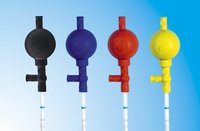Pipet Bulbs
Pipet Bulbs
Flexible, variable-capacity bulbs used to create a vacuum or apply pressure to the liquid contents of serological, volumetric, or transfer pipets to collect, transfer, and dispense liquids; available in various styles and materials.
Kinds of Pipet Bulbs
• Simple suction rubber bulbs or teats for use with small Pasteur pipets or transfer pipets that operate on a simple ‘suck-in and blow-out’ principle
• Larger, heavier-duty simple suction bulbs with thicker walls for larger pipets
• Safety pipet bulbs for use with serological or volumetric pipets that avoid the outdated and unsafe practice of using mouth suction
Safety pipet bulbs are typically made of silicone, natural rubber, or synthetic rubber. They have a tight-fitting nozzle into which the top end of the pipet is inserted. They may have three ‘pinch-and-release’ ball-valve openings operated in sequence to control (1) the expulsion of air from the bulb; (2) the suction of liquid into the pipet; and, (3) liquid discharge. So called ‘flip’ pipet fillers have just two operating valves to facilitate one-handed usage. Most safety bulbs are of a universal ‘one-size-fits-all’ design, and generally accommodate a range of pipet capacities from 1 mL up to 100 mL or more.
How Are pipet Bulbs Used in the Lab?
• Transfer of hazardous reagents and chemicals
• Routine and repetitive dispensing of sample aliquots
• Controlled drop-by-drop transfer of reagents or histological stains
Bulbs are generally washable for repeated use, but care must be taken to avoid ingress of aggressive fluid into the interior of the bulb which could cause contamination, damage, or malfunction.













